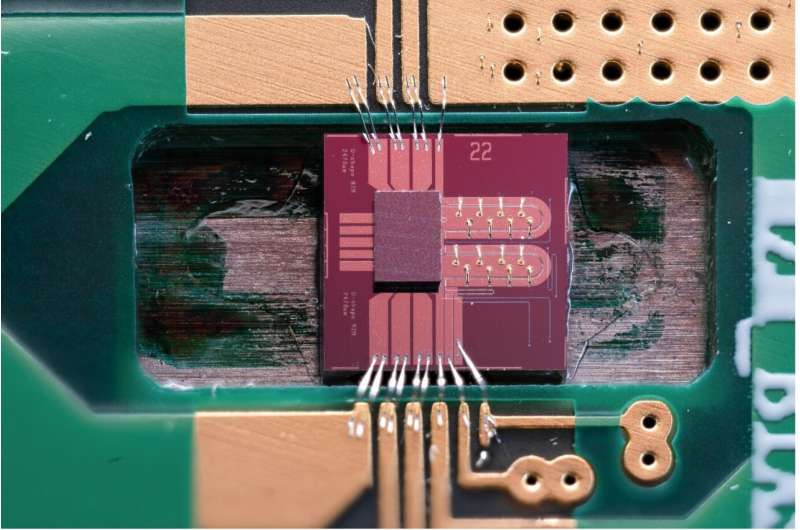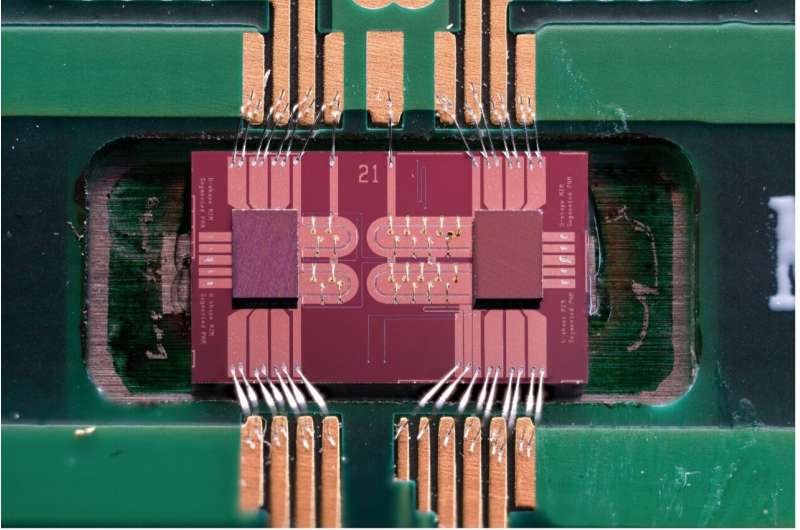November 7, 2023 feature
This article has been reviewed according to Science X's editorial process and policies. Editors have highlighted the following attributes while ensuring the content's credibility:
fact-checked
peer-reviewed publication
trusted source
proofread
An energy efficient transmitter based on a CMOS chip and silicon photonics

The widespread use of electronic devices to interact with others and access the internet has increased the need for highly performing communication technologies that can transmit data faster and more efficiently. Increasing the data transmission rate of devices without adversely impacting their energy efficiency, however, is a challenging task.
Researchers at University of Southampton in the UK recently developed a promising new transmitter based on complementary metal-oxide-semiconductor (CMOS) technology and silicon photonics. This transmitter, introduced in Nature Electronics, was found to achieve remarkable data transmission rates while consuming minimal energy.
"The integration of silicon photonics with electronics is essential for producing practical systems for numerous applications," David J. Thomson, one of the authors of the paper, told Tech Xplore.
"The combination of the optical modulator and its electronic drive amplifier is a key electronic-photonic interface often dictating system performance in terms of speed and power consumption and therefore creating an optimal interface of these two components was identified as an important research direction for us dating back to the year 2010."
Initially, Thomson and his colleagues tried to develop their transmitter using a more conventional approach, which entails designing electrical driver amplifiers and optical modulators separately and then subsequently combining them. They thus experimented with different solutions for electrically connecting these two components, such as wire bonding and flip-chip bonding.
Both these methods did not lead to the results they were hoping for, thus they decided to reach outside of the 'traditional' approach for designing transmitters. Specifically, they adopted an alternative method that involves co-designing the electrical driver amplifier and optical modulator inside the device.

"Adopting our co-design approach, we developed a modeling methodology that was able to incorporate all elements of the integrated transmitter," Thomson explained.
"Detailed simulations demonstrated that to produce a large modulation depth from the optical device its radio frequency response should be modified using electronic inductive structures such that the electrical drive current is used efficiently. The CMOS electronic driver chip was therefore designed with the required functionality to compensate bandwidth limitations of the modulator."
Using their proposed design strategy, the researchers created a transmitter with a relatively slow modulation that is capable of a strong modulation contrast, which can transmit data at high speeds. In initial tests, their device achieved a 112 gigabaud-112 gigabits per second on-off keying rate and a 224 gigabit per second pulse-amplitude modulation.
Remarkably, the device's energy efficiency was below picojoules per bit. The co-design approach employed by Thomson and his colleagues thus enabled a high data throughput while reducing the device's power consumption.
"An alternative research direction in this area is the integration of exotic materials with silicon waveguides for improved modulator performance," Thomson said.
"However, CMOS compatibility is then lost, complicating routes for high-volume, high-yield and low-cost manufacturing. Our work demonstrates that there is still scope for performance improvements from all-silicon based devices which can be fabricated in a low-cost CMOS like manner."
The new transmitter design introduced by this team of researchers could soon inspire the development of similar components aimed at enhancing communications. Overall, their study demonstrates the extent to which unique design strategies can help boost the performance of electronic and photonic devices.
"We believe that advanced CMOS design techniques could be used to fabricate photonics devices and build electronics and photonics devices as integrated functional modules, in which various signal processing functions (such as signal equalization, complex signal formatting and spectral synthesis) could be realized within electrical to optical or optical to electrical conversion processes," Thomson added.
"This is not to suggest that photonics could supersede electronics, but that the convergence of photonics and electronics could enable device performance beyond that of standard electronics modules, not only in terms of speed or bandwidth but also system complexity and energy efficiency. We believe that this integration approach could be used to achieve 200 GBaud transmission with a silicon photonic modulator."
More information: Ke Li et al, An integrated CMOS–silicon photonics transmitter with a 112 gigabaud transmission and picojoule per bit energy efficiency, Nature Electronics (2023). DOI: 10.1038/s41928-023-01048-1
© 2023 Science X Network





















